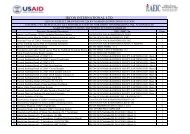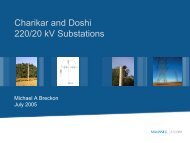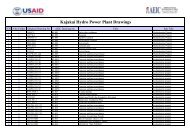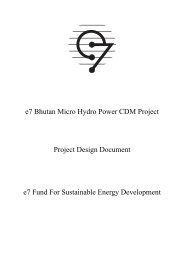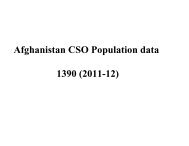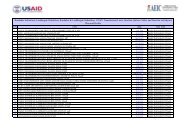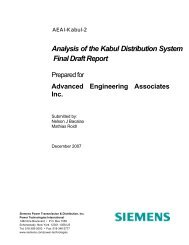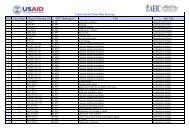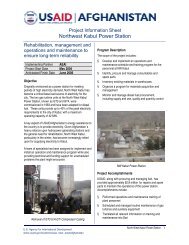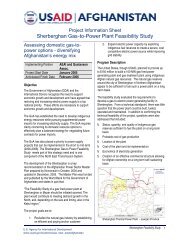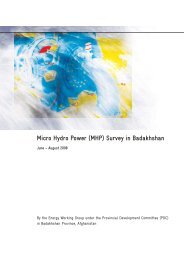prioritization and implementation plan - Cooperazione Italiana allo ...
prioritization and implementation plan - Cooperazione Italiana allo ...
prioritization and implementation plan - Cooperazione Italiana allo ...
Create successful ePaper yourself
Turn your PDF publications into a flip-book with our unique Google optimized e-Paper software.
ACCELERATING AGRICULTURAL AND RURAL DEVELOPMENT<br />
The Agriculture <strong>and</strong> Rural Development Cluster<br />
(ARD) Members: the Ministry of Agriculture,<br />
Irrigation <strong>and</strong> Livestock, the Ministry of Rural<br />
Rehabilitation <strong>and</strong> Development, the Ministry of<br />
Energy <strong>and</strong> Water, <strong>and</strong> the Ministry of Counter-<br />
Narcotics.<br />
Situation Analysis<br />
Afghanistan's rural areas are producing only a<br />
fraction of their potential. The country has more<br />
than enough water resources, but has yet to harness<br />
them fully. Improved wheat seed, coupled with<br />
fertilizer <strong>and</strong> irrigation, can increase yields by 50<br />
percent. Less than 10% of water resources have<br />
been developed, even though irrigation can double<br />
or triple farm yields, as well as make possible the<br />
production of higher-value crops. With<br />
Government support, rural communities are pulling<br />
together to implement community-level projects<br />
that foster economic growth <strong>and</strong> productivity.<br />
Afghanistan’s rural road network has also steadily<br />
exp<strong>and</strong>ed, providing isolated farm communities<br />
with access to inputs, markets, <strong>and</strong> basic services.<br />
Rural communications have improved dramatically<br />
with most parts of the country now having access<br />
to mobile phones <strong>and</strong> modern communications.<br />
Yet much remains to be done.<br />
Afghanistan remains one of the poorest countries<br />
in the world, <strong>and</strong> much of its poverty is situated in<br />
rural areas. About 80% of the population depends<br />
on agriculture <strong>and</strong> associated forms of rural<br />
production. Seasonal <strong>and</strong> chronic unemployment<br />
are common <strong>and</strong> increasing. The result is a high<br />
degree of food insecurity, a socioeconomic<br />
environment that is conducive to instability, an<br />
illicit economy, <strong>and</strong> extreme poverty. Without<br />
significant, visible change to living conditions in<br />
the countryside, insurgents <strong>and</strong> narcotics<br />
traffickers will continue to find willing clients<br />
among Afghanistan’s impoverished villages.<br />
Needed Response<br />
The Agriculture <strong>and</strong> Rural Development Cluster<br />
Goal is the “development of prosperous rural <strong>and</strong><br />
pastoral communities.” Achieving this goal st<strong>and</strong>s<br />
or falls on whether the government, civil society,<br />
<strong>and</strong> the private sector can trigger dramatic<br />
increases in job creation, rural employment, <strong>and</strong><br />
rural growth. To this end, five objectives are<br />
defined that taken together can transform the rural<br />
economy:<br />
First, Afghanistan must develop a basic<br />
information framework to inform government<br />
policies for rural development. Second, it must<br />
improve both the production quality <strong>and</strong> quantity<br />
of agriculture outputs where small interventions<br />
can have an enormous impact. Third, global<br />
experience in developing countries shows that allyear<br />
road access is among the top drivers of rural<br />
transformation. Thus, linkages to markets as well<br />
as access to credit must be improved. Fourth,<br />
Afghanistan must improve food security <strong>and</strong><br />
services to create a healthy population able to<br />
contribute to productive growth, <strong>and</strong> fifth, it must<br />
establish a better regulatory <strong>and</strong> enabling<br />
environment to counter the effects of conflict,<br />
corruption, <strong>and</strong> the deterioration of Afghanistan’s<br />
natural resources.<br />
Finally, rural development has traditionally split<br />
between large programs carried out by a central<br />
government <strong>and</strong> highly localized communities that<br />
largely bypass government activity. This must<br />
change. New partnerships between the Afghan<br />
Government, communities, <strong>and</strong> the private sector<br />
are now guiding <strong>plan</strong>ning for the country’s<br />
Agricultural <strong>and</strong> Rural Development Cluster.<br />
The National Priority Programs presented below<br />
together form a set of activities whose purpose is<br />
to develop an enabling framework that<br />
communities need to build up their productive<br />
assets, reduce insecurity, <strong>and</strong> improve household<br />
incomes across the countryside. They will also be<br />
the main short <strong>and</strong> medium-term means to create<br />
jobs, stabilize rural areas, <strong>and</strong> facilitate people’s<br />
recovery from conflict. Two national labor<br />
intensive programs outlined below are already<br />
operational. Over time, rising production <strong>and</strong><br />
increased economic activity stemming from water<br />
resources projects <strong>and</strong> improved production<br />
28





